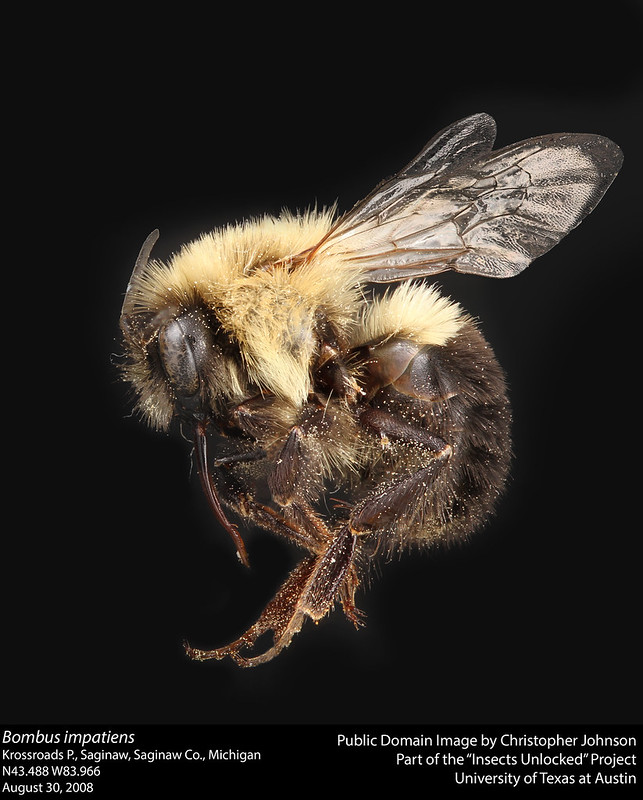Bombus impatiens
| Resource Type | Organism |
|---|---|
| Genus | Bombus |
| Species | impatiens |
| Common Name | Common eastern bumble bee |
| Description | Bombus impatiens, the common eastern bumble bee, is the most commonly encountered bumblebee across much of eastern North America. They can be found in the Eastern temperate forest region of the eastern United States, southern Canada, and the eastern Great Plains. Because of their great adaptability, they can live in country, suburbs, and even urban cities. This adaptability makes them a great pollinator species, leading to an increase in their commercial use by greenhouse industry. This increase consequently led to their farther spread outside their previous distribution range. They are considered one of the most important species of pollinator bees in North America. Source: https://en.wikipedia.org/wiki/Bombus_impatiens Genome update. Previously, the i5k Workspace@NAL hosted Bombus impatiens genome assembly BIMP_2.1 (GCF_000188095.2) and NCBI Bombus impatiens Annotation Release 102. The assembly and annotations have been updated to the most recent assembly, Bombus impatiens genome assembly BIMP_2.2 (GCF_000188095.3), and NCBI Bombus impatiens Annotation Release 103. Please cite the following publication(s) when using this dataset: Sadd, Ben M., et al. "The genomes of two key bumblebee species with primitive eusocial organization." Genome biology 16.1 (2015): 76. doi:10.1186/s13059-015-0623-3 Datasets were provided by BeeBase. |
| Publication | Sadd BM, Barribeau SM, Bloch G, de Graaf DC, Dearden P, Elsik CG, Gadau J, Grimmelikhuijzen CJ, Hasselmann M, Lozier JD, Robertson HM, Smagghe G, Stolle E, Van Vaerenbergh M, Waterhouse RM, Bornberg-Bauer E, Klasberg S, Bennett AK, Câmara F, Guigó R, Hoff K, Mariotti M, Munoz-Torres M, Murphy T, Santesmasses D, Amdam GV, Beckers M, Beye M, Biewer M, Bitondi MM, Blaxter ML, Bourke AF, Brown MJ, Buechel SD, Cameron R, Cappelle K, Carolan JC, Christiaens O, Ciborowski KL, Clarke DF, Colgan TJ, Collins DH, Cridge AG, Dalmay T, Dreier S, du Plessis L, Duncan E, Erler S, Evans J, Falcon T, Flores K, Freitas FC, Fuchikawa T, Gempe T, Hartfelder K, Hauser F, Helbing S, Humann FC, Irvine F, Jermiin LS, Johnson CE, Johnson RM, Jones AK, Kadowaki T, Kidner JH, Koch V, Köhler A, Kraus FB, Lattorff HM, Leask M, Lockett GA, Mallon EB, Antonio DS, Marxer M, Meeus I, Moritz RF, Nair A, Näpflin K, Nissen I, Niu J, Nunes FM, Oakeshott JG, Osborne A, Otte M, Pinheiro DG, Rossié N, Rueppell O, Santos CG, Schmid-Hempel R, Schmitt BD, Schulte C, Simões ZL, Soares MP, Swevers L, Winnebeck EC, Wolschin F, Yu N, Zdobnov EM, Aqrawi PK, Blankenburg KP, Coyle M, Francisco L, Hernandez AG, Holder M, Hudson ME, Jackson L, Jayaseelan J, Joshi V, Kovar C, Lee SL, Mata R, Mathew T, Newsham IF, Ngo R, Okwuonu G, Pham C, Pu LL, Saada N, Santibanez J, Simmons D, Thornton R, Venkat A, Walden KK, Wu YQ, Debyser G, Devreese B, Asher C, Blommaert J, Chipman AD, Chittka L, Fouks B, Liu J, O'Neill MP, Sumner S, Puiu D, Qu J, Salzberg SL, Scherer SE, Muzny DM, Richards S, Robinson GE, Gibbs RA, Schmid-Hempel P, Worley KC. The genomes of two key bumblebee species with primitive eusocial organization.. Genome biology. 2015 Apr 24; 16:76. |
| Organism Image |  |
| Image Credit | Christopher Johnson. View Source. Public Domain . |
 An official website of the United States government.
An official website of the United States government.
